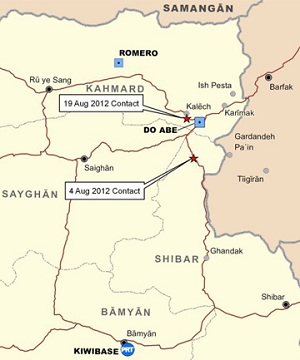
Abdullah Kalta was killed in an ISAF airstrike near Karimak village on Nov. 21, 2012. Photo courtesy of the Nation. |
More than two years after he began his murderous campaign against Coalition forces in central Afghanistan, Taliban commander Abdullah Kalta has been killed in an airstrike in the border region between Bamyan and Baghlan provinces. New Zealand Defense officials said that Abdullah was killed on Nov. 21 with as many as five other Taliban insurgents as they were preparing to ambush elements of the Afghan National Security Forces (ANSF) near Karimak village, a restive area in Bamyan’s Kahmard district. Coalition forces initially reported that Abdullah had been killed in nearby Tala Wah Barfek district in Baghlan province.
According to an International Security Assistance Force (ISAF) press statement from Nov. 24:
Afghan and coalition forces confirmed today the death of a senior member of the Tala Wah Barfek Taliban insurgent network in an operation in Baghlan province Wednesday [Nov. 21]. He was responsible for several attacks on Afghan and coalition forces in the province and was also a mentor for other insurgents. The combined force also killed a number of other insurgents during the operation.
Separately, ISAF spokesman US Air Force Captain Dan Einert told Radio New Zealand that Abdullah was responsible for much of the insurgent activity in Baghlan province and neighboring Bamyan. New Zealand Defense officials have attributed two deadly attacks against their forces to Abdullah — the August 2010 ambush that killed Lieutenant Tim O’Donnell, and the Aug. 19, 2012 roadside bomb attack that killed Corporal Luke Tamatea, Lance-Corporal Jacinda Baker, and Private Richard Harris. Jon Stephenson, a New Zealand reporter based in Kabul, described Abdullah as a “very well-informed and resourced commander,” in an interview with Radio New Zealand.
Abdullah was reportedly behind an attack against Afghan officials in the contested Shibar District in Bamyan in September, but he escaped into Baghlan province shortly after the attack, Stephenson noted in a separate interview.
Despite the recent withdrawal of New Zealand forces from Bamyan’s volatile northern districts, New Zealand Prime Minister John Key stated that troops in Bamyan province, where New Zealand still maintains a 145-man Provincial Reconstruction Team, will be safer now that Abdullah has been killed.
Bamyan remains woefully ill-equipped, however, to deal with insurgents spilling over from troubled nearby areas, namely Baghlan and Parwan provinces. There are currently fewer than 800 Afghan National Police (ANP) personnel operating in Bamyan; and there are no Afghan National Army (ANA) units garrisoned in the province. For a recent analysis of the encroaching insurgency on central Afghanistan and the Afghan government’s challenge in securing the central region, see LWJ report, Insurgency encroaching on central Afghanistan.
Are you a dedicated reader of FDD's Long War Journal? Has our research benefitted you or your team over the years? Support our independent reporting and analysis today by considering a one-time or monthly donation. Thanks for reading! You can make a tax-deductible donation here.








1 Comment
good kill